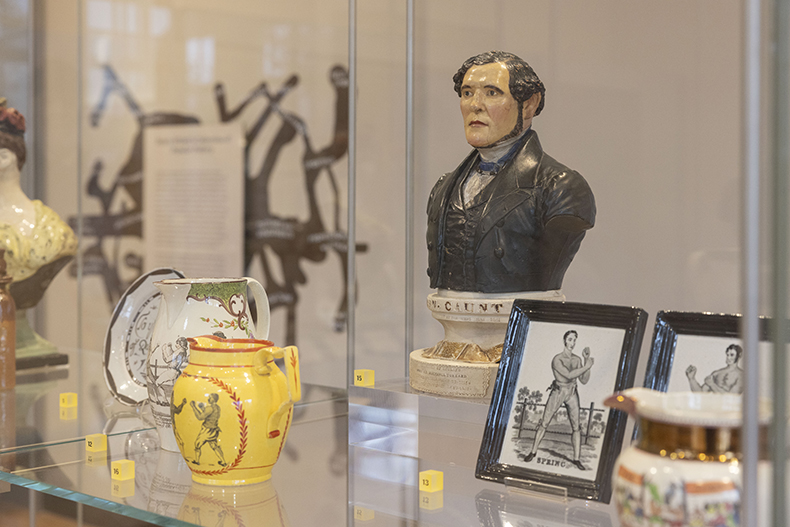In 1852, Henry Cole, the man who would become the first director of the South Kensington Museum (the forerunner of the Victoria and Albert Museum), co-curated a display at Marlborough House that was intended to school the British on their own poor taste. The exhibition ‘False Principles in Design’ – which the press dubbed the ‘Chamber of Horrors’ – featured objects that exemplified all that was wrong, so they thought, with popular styles. These included fabrics and wallpaper with floral designs (a chintz patterned with lilacs showed a ‘want of repose’), as well as items designed to look like something other than themselves or decorated with something too, well, decorative. The catalogue railed against British designers ‘who think novelty better than chaste design, and show preferable to truth’.
Not long after, in Brighton, another Henry began putting together a collection that Cole would have despised. It is now on show at the V&A in the exhibition ‘Henry Willett’s Collection of Popular Pottery’, which comprises 150 ceramics collected by a wealthy brewer and businessman in Brighton between the 1860s and the end of the century. The display represents just a small fraction of Willett’s cross-disciplinary collections – he also amassed Old Master paintings, fossils, folk art from his native Sussex and historic torture devices allegedly used by the Spanish Inquisition. In 1873, Willett loaned some of his ‘popular pottery’ collection to the newly formed Brighton Museum, of which he was a co-founder, and in 1903 he donated more than 2,000 ceramics to the institution, which it still holds today.

Display with a bust of Benjamin Caunt, by H. Bentley (c. 1844). Royal Pavilion & Museums, Brighton & Hove. (CC BY-SA)
Unlike Cole, who deemed tableware with pictures on it ‘objectionable’ and excessive decoration ‘improper’, Willett understood the appeal of the cheap and cheerful. He also believed that demotic designs provided insights into the nation’s story. As he put it, ‘the history of a country may be traced on its homely pottery.’ He began collecting ceramics that reflected what might be ‘found on the mantelpieces of English cottage homes’, focusing on the period between 1600 to 1900. Willett categorised his finds according to 23 themes, which he described as ‘confessedly arbitrary’. These included Royalty & Loyalty, Soldiers & Sailors, Crime, Philanthropy, Music, Sport, Conviviality & Teetotalism and Domestic Incidents, as well as Poetry, Science & Literature.
The resulting collection is a marvellous thing. There are fun novelties: a knobbly potato-shaped flask; a cup shaped like a fish’s head (both c. 1790); a jug in the form of a wonderfully lugubrious cat (c. 1672). These coexist with more sober fare: a jug decorated with a guillotine, whose inscription mentions ‘Louis XVI, the late king of France who suffered on the Scaffold Jan 21 1793’; a massive and stolid jug simply inscribed ‘Church & King’ (1814); and a variety of pieces promoting temperance (ironic, considering Willett’s own trade).

Chamber Pot containing the bust of Napoleon (c. 1805). Royal Pavilion & Museums, Brighton & Hove. (CC BY-SA)
It’s possible to trace the changing fortunes of celebrities and politicians through these mugs, cups, plates, tiles, plaques, Toby Jugs, regular jugs and assorted knick-knacks. A bust of Napoleon made in Staffordshire c. 1802 depicts Napoleon Bonaparte in statesmanlike fashion, despite its lurid colouring. A very similar bust – perhaps from the same mould – reappears inside a chamber pot of c. 1805 alongside the Latin ‘PEREAT’, meaning ‘Let him perish’. It’s hard to convey a shift in public opinion more clearly than through this exhortation to piss on the emperor’s head. In a jug from 1813, the year after the disastrous invasion of Russia, Napoleon is shown doll-like and helpless in the grasp of a huge black bear.
Willett was correct in his belief in the historic insights that such a collection can provide. But viewing it today, I’m also struck by how little has changed in the national psyche. There are pots about drinking, with inscriptions such as ‘Oh How Charming Is Good Liquor’ – surely the equivalent of modern-day trinkets with slogans like ‘A balanced diet is a glass of wine in each hand’ or ‘It’s 5 o’clock somewhere’.

Figure Group and Model relating to the Red Barn Murder (c. 1829). Royal Pavilion & Museums, Brighton & Hove. (CC BY-SA)
Our taste for true crime is there too, in pottery designed to cash in on stories from the penny dreadfuls. These range from the folkish – a figure group of Maria Marten, her murderous lover William Corder and the Red Barn under which he buried her corpse in 1827 – to the surreal, such as a court scene reimagined with animal-headed humans. (The subject, the case of the so-called Tichborne claimant, still appeals to the popular imagination: Zadie Smith fictionalised it in her novel The Fraud just last year.)
Then as now, there is satire of the metropolitan elite and their fads and fancies. A plate and mug from c. 1775 feature one ‘Signor Gruntinelli’ playing ‘a new instrument call’d a swinetta’: a pig held under his arm like a bagpipe, tail ready to be pulled. A figurine group from c. 1820 of a musician serenading three dogs in coats and hats, dancing on their hind legs, shows that the desire to laugh at funny animals truly transcends the centuries. These are memes made material.

Pair of figure groups depicting the Tichborne Trial (c. 1874), modelled by Randolph Caldecott. Royal Pavilion & Museums, Brighton & Hove. (CC BY-SA)
‘Henry Willett’s Collection of Popular Pottery’ is at the V&A, London, until 29 September.














![Masterpiece [Re]discovery 2022. Photo: Ben Fisher Photography, courtesy of Masterpiece London](http://zephr.apollo-magazine.com/wp-content/uploads/2022/07/MPL2022_4263.jpg)
‘Like landscape, his objects seem to breathe’: Gordon Baldwin (1932–2025)